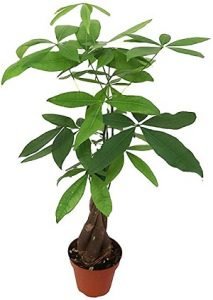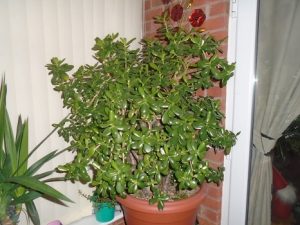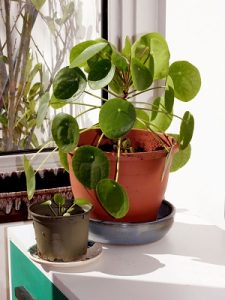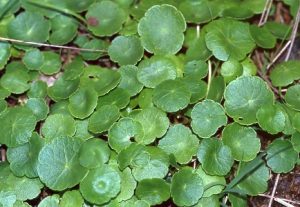Money trees are often plant enthusiasts’ go-to indoor plants. They add to the beauty and give a touch of green in your house, giving that homely feeling. So you want to plant a money tree, but you are not sure if that is a good idea because a money tree could be toxic to your cat. If this is you, we have got you covered!
In this article, we will walk through the different types of money trees (there are many!), and whether they are toxic or safe for your cat to be around. We will also provide some substitutes for the money plant that you opt for if the money plant does not suit your cat.

Are money trees toxic to cats?
Before going into the different types of money trees, let’s see whether they are toxic to cats or not.
We can not assume that all types of money trees are toxic for cats, because even though they are all grouped under and referred to as money trees, they belong to different families so each trees’ properties differ.
Basically among the different types of money trees, some are toxic, and some are of them are non-toxic.
The degree of toxicity differs for each tree as we will discuss below, but if you care for your feline friend, it is best to avoid planting money trees at home altogether.
Types of money trees
This may come as a shock to you, but there are many different types of money trees. Each of them has different characteristics and appearances, but they go by the name money trees in the market, hence the list.
So let’s dive right in and learn about these plants, then we will see whether money trees are toxic to cats or not.
Classic Money Plant (Pachira Aquatica)
The classic money plant is the most common plant that we refer to when talking about planting money plants. The family name of this plant is Pachira Aquatica and its origins are from South and Central America.
Classic Money Plants are low maintenance plants, all they need is regular watering, some sunlight, and basic soil. You allow the soil to dry up before watering again for proper growth, and voila! You have a long and beautiful money tree in a few days’ time.
Now, some people have very specific concerns which are understandable, because a long decorative plant and a curious cat is some combination! Your cat may be very excited about the money tree and even attempt to tear the leaves apart at some point.
If you want to plant a classic money tree, you should go ahead because a classic money tree is not toxic for cats. It can be a little harmful though if your cat ingests the leaves. It could be inflicted with minor diarrhea and an upset stomach, but nothing serious that we would call toxic.

Jade Plant (Crassula Ovata)
Coming to the next type of plant, Crassula Ovata is also called the jade plant but is also known by the name money plant.
Weirdly enough, Pachira Aquatica and Crassula Ovata do not look similar at all, but because they go by similar names in the market, we thought we should mention it here.
The Classic Money Tree has a thin trunk with many leaves attached to the stems, but the jade plant is more of a succulent instead of a tree.
It also grows in a different direction and has different properties from other trees. Crassula Ovata isn’t the best for cats to be around, because its leaves contain chemicals that can cause poisoning in the cat’s body.
Hence, if you are thinking about planting a jade plant or already have one at home, you should think about your cat’s health and take appropriate measures.

Chinese Money Plant (Pilea Peperomioides)
Chinese Money plants or Pilea Peperomioides are a very common type of money plant that people plant at home. Taking care of a Chinese money plant is easy, you just water them once a week and keep them away from direct sunlight.
This plant will also pique your cat’s interest, especially its leaves, but a Chinese money plant is usually safe for homes with cats just like Brussel Sprouts unless they ingest the leaves too often.
If your cat ingests the leaves too often and falls sick, then you should consider removing the plant from your home.

Pothos (Epipremnum Aureum)
Pothos is from the family of Epipremnum Aureum, and also comes under the broad types of a money plant. It is also called devil’s ivy and is declared not to be safe for cats.
It is known to be toxic for cats and affects the internal functions of the body. So if you have a cat at home, you should avoid planting Pothos money trees and get one of the substitutes we have mentioned below.
Similar to the jade tree, pothos has caused severe complications in cats’ bodies and has even proved to be fatal to some cats. So it is important that you keep this in mind when choosing a money tree.

Pennywort (Hydrocotyle Vulgaris)
Pennywort is a money tree that has broad leaves and low stems. It originates mainly from California. Pennywort is not toxic for cats, so if you’re thinking of planting a pot of pennywort money tree, then you can do so without hesitation.
Pennywort is one of the most feasible options if you want to get a money plant for your home, as it is only mildly harmful if your cat ingests huge amounts of the plants’ leaves.

Honesty Flowers (Lunaria)
Honesty Flower is also called Silver Dollar Money Tree, and it looks nothing like the trees we mentioned above.
They are also very toxic to cats. Many cats have been inflicted with excretion problems, blood problems, and even severe cases of vomiting and depression. For the sake of your feline friend, avoid planting honesty flowers indoors like the plague.

How to stop my cat from eating a money tree?
There are many ways you can stop your cat from eating money tree leaves.
Don’t plant indoors
The first way is to not plant any money tree plants indoors at all. Either you avoid planting the trees completely, or you plant them outdoors. You will still have to keep an eye on your cat if you decide on outdoors though.
Use a repellent substance
The second option you can opt for is to put something off-putting near the plant, meaning, you can cover the pot with some sort of repellant or pungent substance so that your cat will not go near the pot.
The science behind this is that cats usually do not attempt to go near a pungent-smelling substance after the first or second try. We’ll take this opportunity to tell you to be careful about the substance you use, otherwise, it could leave your house smelling bad or your cat sick if it ingests any of the material.
Plant a “distraction plant”
It’s not as complex as it sounds. If you want to plant a money tree indoors at all costs, then one option is to plant another non-toxic plant that your cat would want to play with instead.
A good plant option is the catnip plant. Cats go crazy for catnip. However, their attention spans only last for about 10 minutes on catnip, so then your cat might attempt to play with the money tree as well.
Hang plants on the wall or a high surface
Another option you can go for is to plant the trees in a hanging pot on the wall or somewhere where the cat can’t reach it. This is unlikely to work though because the cat whiskers will work their magic and allow the cat to jump tall heights to get what it wants.
What to do if my cat has eaten money tree leaves?
If your cat has ingested the non-toxic money tree leaves (based on the guide mentioned above), then you don’t need to worry much.
Just keep an eye on it for a while and if you see any signs of diarrhea, then just take it to the vet.
However, if the cat has ingested leaves of one of the toxic categories of money trees, then you should take it to the vet immediately.
Not taking your cat to the vet in time could lead to severe consequences, as the toxic leaves can cause vomiting and poisoning in the cat’s body internally and cause weakness.
Substitutes to money trees
Were you waiting for this part? If you are looking for some non-toxic alternatives to money trees, then we’ve got you covered, here are some of the cat-safe plants you can plant indoors or outdoors:
- Spider Plant
- Christmas Cactus
- Ponytail Palm
- Earth Star Bromeliad
- Moth Orchid
Worried about your cat ingesting the money tree leaves? Not anymore. You can beautify your home without risking your cat’s health. Similar to Cactus care should be taken with Money Trees too.
Conclusion
In conclusion, are money trees toxic for cats? Yes and no, depending on the type of money we are talking about.
Some kinds of plants are toxic for cats, while other types of money plants are not as bad, though ingesting any leaves should be strictly avoided.
There are many ways you can avoid your cat eating a money tree, we’ve gone through some of them in this article.
However, if your cat does eat any leaves, you should evaluate how serious the situation is and take it to the vet immediately.
Lastly, we have also provided a list of alternate plants that you can pot at home if you don’t want to put your cat at risk of poisoning.
Stay safe!
